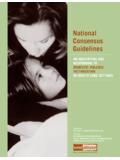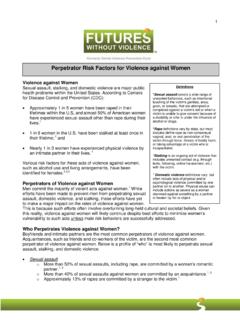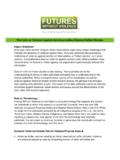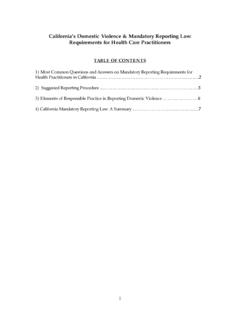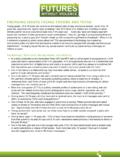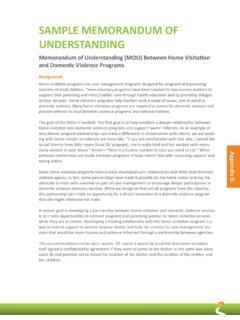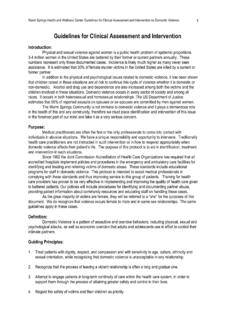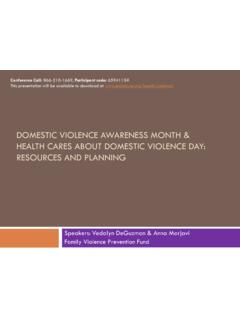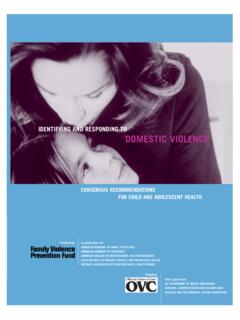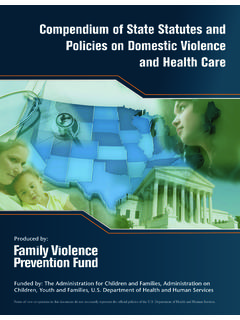Transcription of THE FACTS ON TWEENS AND TEENS, AND DATING …
1 THE FACTS ON TWEENS AND teens , AND DATING violence While DATING , domestic and sexual violence affect women regardless of their age, teens and young women are especially vulnerable. Young people, 12 to 19 years old, experience the highest rates of rape and sexual assault,i and youth, 18-19 years old, experience the highest rates of Add to that the million children who live in families in which intimate partner violence occurred at least once in the past yeariii, and you have a huge number of young people in this country whose lives are affected sometimes shaped by violence . Prevalence of violence in TWEENS Approximately one in three adolescent girls in the United States is a victim of physical, emotional or verbal abuse from a DATING partner a figure that far exceeds victimization rates for other types of violence affecting In a national online survey, one in five TWEENS age 11 to 14 say their friends are victims of DATING violence and nearly half who are in relationships know friends who are verbally abused.
2 Two in five of the youngest TWEENS , ages 11 and 12, report that their friends are victims of verbal abuse in A survey of 7th graders in a high-risk community found that more than one in three boys ( percent) and nearly one in four girls ( percent) reported being a victim of physical DATING violence in the past The same study found that nearly one in four 7th grade girls ( percent) and more than one in five boys ( percent) reported perpetrating physical violence in a DATING relationship in the past A small study of middle school Latino youth 11 to 13 years old found that 14 percent of girls and 13 percent of boys disclosed experiencing physical DATING violence in the past Boys are more likely to inflict injuries as a result of perpetrating DATING violence than This trend where girls slap and push and boys hit and punch continues into adulthood.
3 Women suffer from much higher rates of domestic violence and incur more injuries. In 2008, the Centers for Disease Control and Prevention published data collected in 2005 that finds that women experience two million injuries from intimate partner violence each The cost of intimate partner rape, physical assault and stalking is in the billions of Prevalence of violence in teens One in three adolescent girls in the United States is a victim of physical, emotional or verbal abuse from a DATING partner a figure that far exceeds victimization rates for other types of violence affecting Nationwide, nearly one in ten ( ) of high school students has been hit, slapped or physically hurt on purpose by their boyfriend or girlfriend in the past twelve months. Overall, the prevalence of DATING violence was higher among black ( ) and Hispanic ( ) students compared to white ( ) students.
4 Xiii teens in same-sex relationships experience rates of violence and abuse similar to rates experienced by teens in heterosexual relationships. Findings from the National Longitudinal Study of Adolescent Health indicated that nearly one in four teens and young adults (ages 12-21 years) in same-sex romantic or sexual relationships reported some type of partner violence victimization in the past year-and-a-half. One in ten reported experiencing physical violence by a DATING partner. Females were more likely to report victimization than Nearly one in ten 15-year-old girls disclosed experiencing physical DATING violence and one in four disclosed experiencing psychological Nearly one in three sexually active adolescent girls in 9th to 12th grade ( percent) report ever experiencing physical or sexual violence from DATING More than one-third of high school age boys ( ) and girls ( ) with both-sex partners reported physical DATING violence in the past One in four teen girls in a relationship (26 percent)
5 Says she has been threatened with violence or experienced verbal abuse, and 13 percent say they were physically hurt or One in three teens reports knowing a friend or peer who has been hit, punched, kicked, slapped or physically hurt by a School and Academic Performance Having been a victim of physical DATING violence was significantly associated with lower than average grades and poor school attachment for male and female students in grades 7 through Aggressive behavior at school during early adolescence predicted future DATING violence victimization among 12th Some Parents Are Out of Touch In a 2009 survey of parents, three in four parents say they have had a conversation with their teen about what it means to be in a healthy relationship but 74 percent of sons and 66 percent of daughters said they have not had a conversation about DATING abuse with a parent in the past Though more than four in five parents (82 percent) feel confident that they could recognize the signs if their child was experiencing DATING abuse, a majority of parents (58 percent) could not correctly identify all the warning signs of In a survey with a representative sample of teens (ages 13-18), nearly half (42%) said their parents know nothing or very little about what they do Of teens in an abusive relationships, fewer than one in three (32 percent)
6 Confide in their parents about their abusive In a national on-line survey of parents with children 11-18 years old, nearly half (45%) had not discussed DATING violence with their children in the past year. Reasons parents did not discuss DATING violence with their children included they thought their children were too young to talk about it, they would not know what to say, and their children would learn about it through i Truman, Jennifer and Rand, Michael. 2010. Criminal Victimization, 2009. Department of Justice Bureau of Justice Statistics. Available at ii Baum, Katrina, Catalano, Shannan, Rand, Michael and Rose, Kristina. 2009. Stalking Victimization in the United States. Department of Justice Bureau of Justice Statistics.
7 Available at iii McDonald, R, Jouriles, E, Ramisetty-Mikler, S. et al. 2006. Estimating the Number of American Children Living in Partner-Violent Families. Journal of Family Psychology 20(1): 137-142. iv Davis, Antoinette, MPH. 2008. Interpersonal and Physical DATING violence among teens . The National Council on Crime and Delinquency Focus. Available at v Tween and Teen DATING violence and Abuse Study, Teenage Research Unlimited for Liz Claiborne Inc. and the National Teen DATING Abuse Helpline. February 2008. Available at vi Swahn MH, Simon TR, Arias I & Bossarte RM. 2008. Measuring Sex Differences in violence Victimization and Perpetration Within Date and Same-Sex Peer Relationships. Journal of Interpersonal violence 23(8):1120-1138. vii Ibid. viii Yan, Fang; Howard, Donna; Beck, Kenneth; Shattuck, Teresa; and Hallmark-Kerr, Melissa.
8 2010. Psychosocial Correlates of Physical DATING violence Victimization Among Latino Early Adolescents. Journal of Interpersonal violence . First published on July 7, 2009. ix Swahn, Monica; Simon, Thomas; Hertz, Marci; Arias, Illeana, et al. 2008. Linking DATING violence , Peer violence , and Suicidal Behaviors Among High Risk Youth. American Journal of Preventative Medicine. 2008: 34(1): 30-38. x Adverse Health Conditions and Health Risk Behaviors Associated with Intimate Partner violence , Morbidity and Mortality Weekly Report. February 2008. Centers for Disease Control and Prevention. Available at xi Costs of Intimate Partner violence Against Women in the United States. Centers for Disease Control and Prevention, National Center for Injury Prevention and Control. 2003.
9 Available at xii Davis, Antoinette, MPH. 2008. Interpersonal and Physical DATING violence among teens . The National Council on Crime and Delinquency Focus. Available at xiii Centers for Disease Control and Prevention. Youth Risk Behavior Surveillance-United States, 2011 MMWR 2012;61(4):10. xiv Halpern CT, Young ML, Waller MW, Martin SL & Kupper LL. 2004. Prevalence of Partner violence in Same-sex Romantic and Sexual Relationships in a National Sample of Adolescents. Journal of Adolescent Health. 35(2): 124-131. xv Hebert M, Lavoie F, Vitaro F, McDuff P & Tremblay RE. 2008. Association of Child Sexual Abuse and DATING Victimization with Mental Health Disorder in a Sample of Adolescent Girls. Journal of Traumatic Stress. 21(2): 181-189. xvi Decker M, Silverman J, Raj A.
10 2005. DATING violence and Sexually Transmitted Disease/HIV Testing and Diagnosis Among Adolescent Females. Pediatrics. 116: 272-276. xvii Preeti P & Schillinger JA. 2010. Sexual Behaviors and Sexual violence : Adolescents with Opposite-, Same-, or Both-Sex Partners. Pediatrics. 126(5):879-886. xviii Liz Claiborne Inc. 2005. Omnibuzz Topline Findings-Teen Relationship Abuse Research. Teenage Research Unlimited. Available at xix Ibid. xx Banyard VL, Cross C. 2008. Consequences of Teen DATING violence : Understanding Intervening Variables in Ecological Context. violence Against Women. 14:998-1013, xxi Makin-Byrd K & Bierman KL. 2012. Individual and Family Predictors of the Perpetration of DATING violence and Victimization in Late Adolescence. Journal of Youth and Adolescence.
